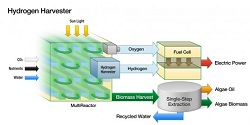Many reports in the past year have come out and determined that alternative energy such as wind and solar will have a major impact by 2030. However, in a new report released today, the Boston Consulting Group (BCG) says that the impact could happen sooner than others predict. “What’s Next for Alternative Energy?” examines seven influential and promising alternative energy technologies including advanced biofuels, electric vehicles (EVs), concentrated solar power (CSP), solar photovoltaic (PV), onshore and offshore wind, and clean coal through carbon capture and sequestration (CCS).
The success of each alt energy was determined based on three key issues:
- • Can it achieve cost competitiveness with conventional energy by 2020 and be economically viable without subsidies?
- • Can it overcome barriers to rapid adoption once cost competitive?
- • Can it reach penetration levels by 2025 that disrupt the status quo?
 The report contains many key findings but several of note. In particular, as costs rapidly decrease for the production of advanced biofuels, CSP and solar PV, they will become cost competitive within the next five to ten years. In addition, onshore wind power will see steady adoption and continued growth but still faces a barrier with energy storage limitations and cost. Conversely the report determined that offshore wind will continue to struggle to move beyond subsidy-driven growth.
The report contains many key findings but several of note. In particular, as costs rapidly decrease for the production of advanced biofuels, CSP and solar PV, they will become cost competitive within the next five to ten years. In addition, onshore wind power will see steady adoption and continued growth but still faces a barrier with energy storage limitations and cost. Conversely the report determined that offshore wind will continue to struggle to move beyond subsidy-driven growth.
Other interesting findings include the conclusion that EVs will see steady adoption and will become economically feasible by 2020, and clean coal through CCS will have very slow adoption and will not be viable for a decade or more.
“There is no question that conventional energy sources will constitute the bulk of the world’s energy for at least the next couple of decades,” said Balu Balagopal, a Houston-based senior partner at BCG and a coauthor of the report. “But a few of these green-energy technologies will make their presence felt very likely within the next few years.”Their costs are falling quickly and significantly, pushing them closer to where they can compete on price—without subsidies—against fossil-fuel-based sources.”
Balagopal continued by explaining that as they become more cost-competitive, adoption will be constrained more by barriers such as the need to develop infrastructure. “However, we believe these barriers will likely prove surmountable,” concluded Balagopal.






 The latest reports from the U.S. Department of Agriculture are lowering the forecast for this year’s corn crop, but raising the expected use of corn for ethanol.
The latest reports from the U.S. Department of Agriculture are lowering the forecast for this year’s corn crop, but raising the expected use of corn for ethanol.  In a letter hand to President Obama this week, RFA President and CEO Bob Dinneen urged the Obama Administration to maintain its commitment to the commercialization of cellulosic ethanol and other advanced biofuels. The RFA letter is in response to a White House memo seeking presidential guidance on the future of the Department of Energy (DOE) loan guarantee program.
In a letter hand to President Obama this week, RFA President and CEO Bob Dinneen urged the Obama Administration to maintain its commitment to the commercialization of cellulosic ethanol and other advanced biofuels. The RFA letter is in response to a White House memo seeking presidential guidance on the future of the Department of Energy (DOE) loan guarantee program. Farm and food petitioners in the suit, which was filed with the U.S. Court of Appeals for the District of Columbia Circuit, include the Grocery Manufacturers Association, the American Meat Institute, the National Council of Chain Restaurants, the National Meat Association, the National Turkey Federation, the National Chicken Council, the National Pork Producers Council, the Snack Food Association and the American Frozen Food Institute.
Farm and food petitioners in the suit, which was filed with the U.S. Court of Appeals for the District of Columbia Circuit, include the Grocery Manufacturers Association, the American Meat Institute, the National Council of Chain Restaurants, the National Meat Association, the National Turkey Federation, the National Chicken Council, the National Pork Producers Council, the Snack Food Association and the American Frozen Food Institute. 

